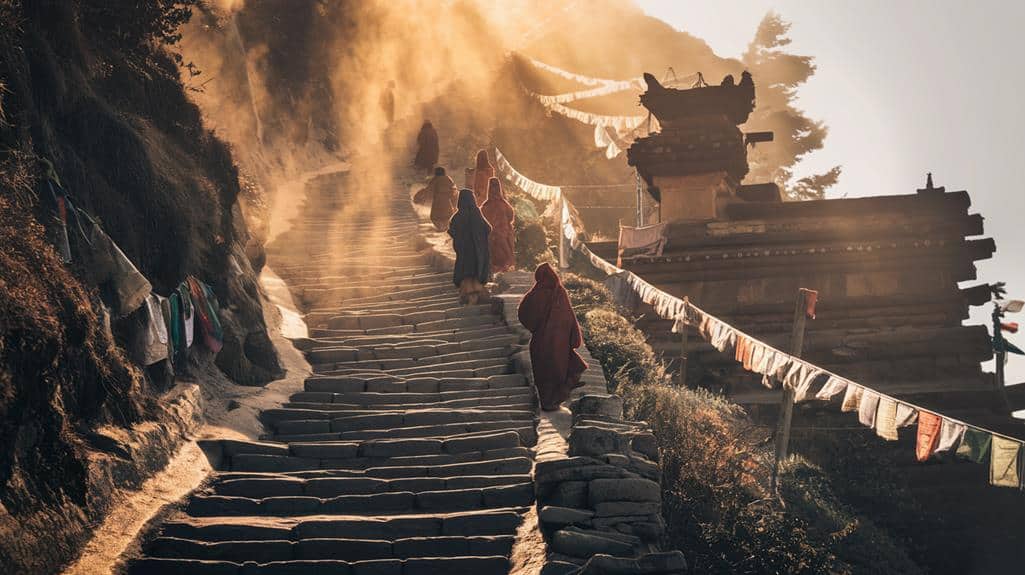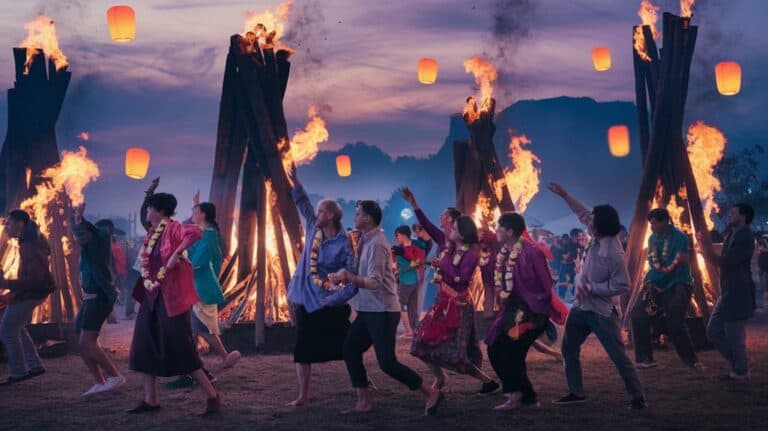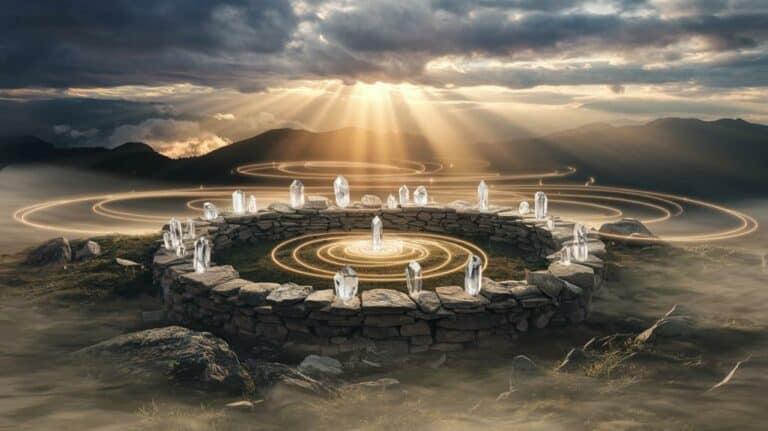The Role of Pilgrimage in Mystical Traditions
You’ll find that pilgrimage transcends the simple act of walking from point A to point B—it’s a deliberate journey into the depths of spiritual transformation that mystics have undertaken for millennia. As you consider the ancient pathways that wind through mountains, deserts, and sacred sites worldwide, you’ll discover how physical movement becomes a gateway to profound inner awakening. Whether it’s the Camino de Santiago or Mount Kailash, these sacred routes hold secrets that countless seekers have uncovered through their steps. The question isn’t just where these paths might lead you, but how they’ll reshape your understanding of what lies beyond the visible world.
The Essence of Sacred Journey
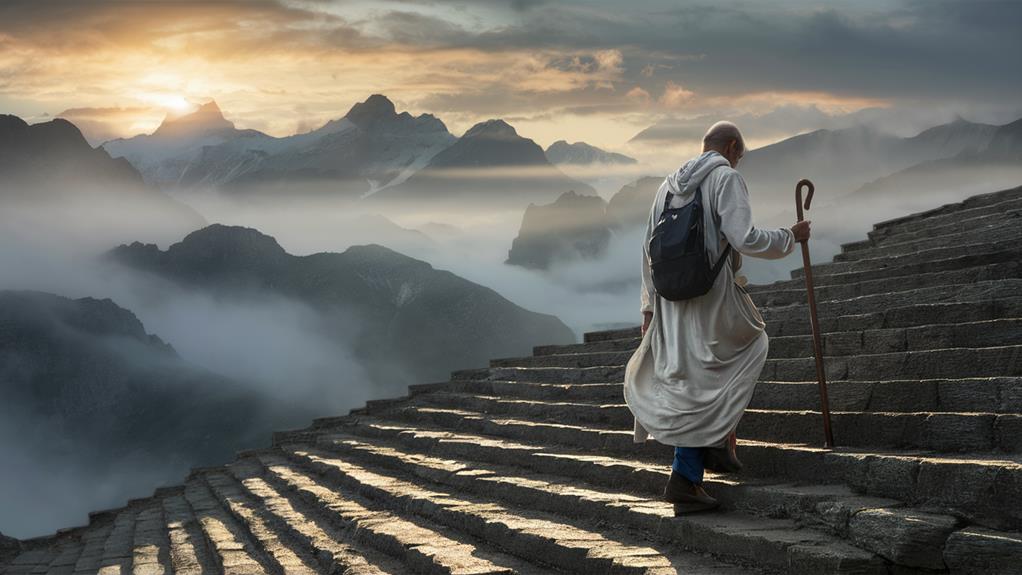
What transforms an ordinary journey into a sacred pilgrimage? It’s when you step beyond mere physical movement and enter a domain where each footstep carries the weight of intention and meaning.
You’ll find that a sacred journey isn’t measured in miles but in moments of transformation, where the external path mirrors your inner quest for understanding.
As you traverse these hallowed routes, you’re participating in a tradition that’s whispered through centuries of human longing. You’re not just walking – you’re weaving your story into an ancient tapestry of seekers who’ve traced these same steps before you.
The landscape becomes your teacher, and the hardships you encounter aren’t obstacles but opportunities for deeper revelation.
When you begin a pilgrimage, you’ll discover that time shifts its ordinary pace. The familiar markers of daily life fall away, and you enter a space where every encounter holds potential for enlightenment.
Your journey becomes a moving meditation, where the sacred isn’t found at the destination but in the very act of seeking, in the silent conversations between your soul and the path that beckons you forward.
Physical Movement as Spiritual Growth
The rhythmic motion of walking on a sacred path creates a unique bridge between body and spirit. As you move forward step by step, you’ll find that physical movement becomes a meditation in motion, transforming mundane footsteps into a dance of devotion. Your body’s natural rhythm aligns with the ancient cadence of countless pilgrims who’ve walked these paths before you.
When you’re climbing steep mountain trails to reach a sacred shrine or crossing vast deserts to touch holy ground, you’re not just covering physical distance – you’re traversing the landscape of your inner world. Each step you take becomes a prayer, each breath an offering, as your muscles and sinews participate in the sacred act of seeking.
You’ll discover that the physical challenges you face – the blisters, the exhaustion, the elements – aren’t obstacles but teachers, showing you how your limitations can become gateways to transcendence.
The relationship between movement and spiritual awakening isn’t coincidental; it’s integral to the pilgrim’s journey. Your body becomes the vessel through which divine understanding flows, making physical motion inseparable from spiritual progress.
Historical Roots of Mystic Pilgrimage
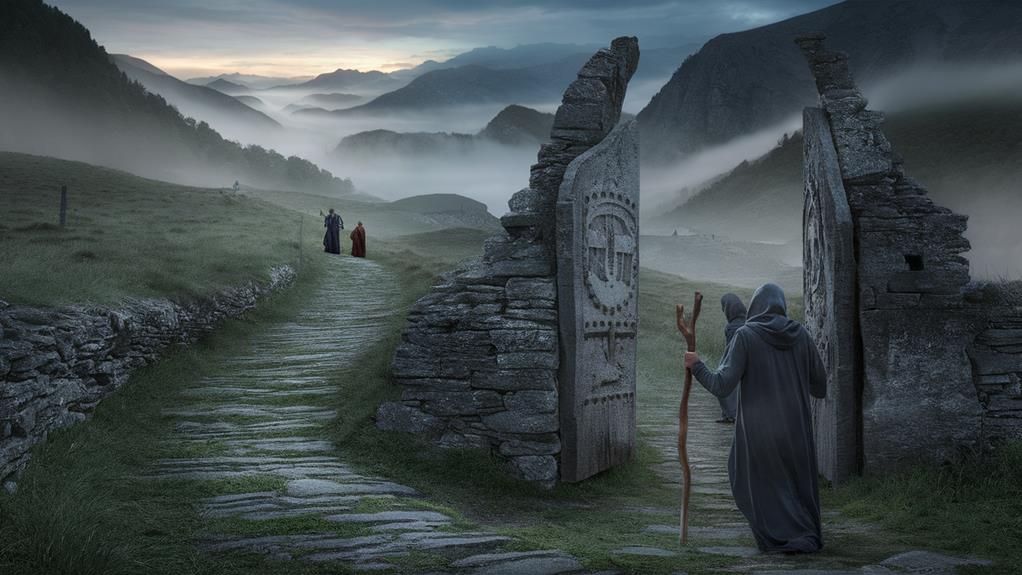
Ancient civilizations laid the groundwork for mystical pilgrimage traditions that continue to shape spiritual practices today. You’ll find their footprints in the ancient Egyptian journeys to Abydos, where seekers walked hundreds of miles to connect with Osiris.
You can also see this in the Celtic paths to sacred wells where wisdom was believed to flow from the otherworld. These early pilgrimages weren’t merely physical journeys but transformative rituals that mapped the soul’s evolution.
As you trace these historical threads, you’ll discover how medieval mystics built upon these foundations, establishing routes like the Camino de Santiago, where countless souls have sought enlightenment through movement and contemplation.
The ancient Hindu traditions of tirtha-yatra, or sacred journeys, reveal how pilgrimage became intertwined with the quest for self-realization.
You’re inheriting a legacy where Sufi wanderers crossed deserts seeking divine union, and Buddhist practitioners circumambulated sacred mountains to align with cosmic forces.
These historical patterns show you how the human spirit has consistently sought transformation through sacred movement, creating pathways that still resonate with modern seekers who yearn to connect with something greater than themselves.
Sacred Geography and Holy Sites
Sacred geography emerges from within the mystic traditions as a tapestry of power points and energy centers across Earth’s surface. You’ll find these sites scattered across continents, each pulsing with what mystics describe as concentrated spiritual frequencies – from Glastonbury’s ancient tor to Mount Kailash’s snow-capped peak.
These aren’t merely physical locations; they’re gateways where you’ll experience the intersection of material and spiritual dimensions. As you explore these sacred spaces, you’ll discover how they’re often aligned with celestial bodies or situated along ley lines, creating what many traditions call the Earth’s energetic grid.
You’ll notice how certain places – like Sedona’s red rocks or the pyramids of Egypt – seem to amplify your spiritual awareness naturally. Indigenous peoples have long recognized these power spots, marking them with stone circles, temples, or simple shrines.
Whether you’re drawn to Christianity’s Santiago de Compostela, Islam’s Kaaba, or Buddhism’s Bodh Gaya, you’re connecting to sites where countless seekers before you have experienced profound transformation. These locations serve as anchors for collective spiritual consciousness, drawing pilgrims who seek to tap into their transformative energies.
Transformation Through Sacred Walking
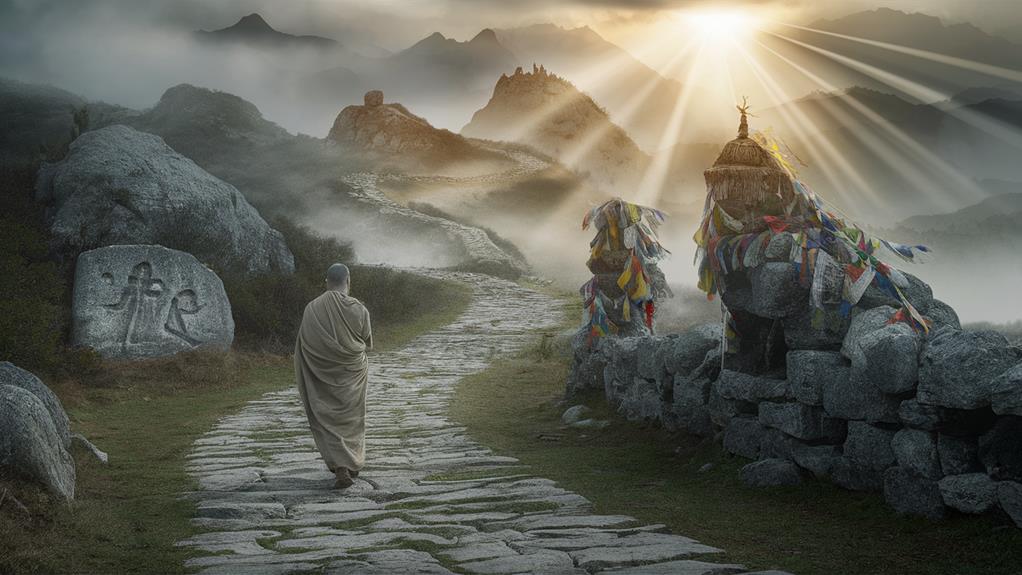
Many spiritual seekers discover that walking becomes meditation in motion during pilgrimage, transforming ordinary footsteps into profound acts of devotion. As you traverse ancient pathways, you’ll find that each step carries the weight of countless souls who’ve walked before you, creating an invisible thread that connects you to centuries of spiritual practice.
Your feet begin to tell a story of transformation, where the physical journey mirrors your inner passage through layers of consciousness.
You’ll notice how the rhythm of your walking creates a natural mantra, as your breath synchronizes with your movement and your mind gradually releases its grip on everyday concerns. The landscape you’re crossing becomes more than mere scenery – it transforms into a living text that you’re reading with your entire being.
Through blisters and fatigue, you’re learning to embrace discomfort as a teacher, while the simplicity of putting one foot before the other strips away life’s complexities. In this sacred walking, you’re not just covering distance – you’re crossing thresholds of understanding, where each mile marks another layer of self-discovery peeled away.
Collective Experience of Sacred Travel
While personal transformation marks each pilgrim’s journey, the shared experience of sacred travel creates an extraordinary tapestry of human connection. You’ll find yourself walking alongside strangers who quickly become companions, sharing water, bread, and stories that bridge cultural divides.
In these sacred spaces, you’re part of something far greater than yourself – a living, breathing community of seekers united in purpose. As you move through ancient paths, you’ll discover how collective energy transforms ordinary moments into profound experiences.
The shared rituals – whether it’s touching worn stones that countless hands have smoothed before yours or joining voices in prayer at dawn – connect you to an unbroken chain of pilgrims stretching back through centuries. You’re experiencing what anthropologists call “communitas,” where social hierarchies dissolve and you’re bound together by something deeper than everyday identities.
This collective dimension isn’t just about companionship; it’s about witnessing how sacred travel dissolves the illusion of separation. In the shared challenges, celebrations, and silent moments of awe, you’ll find that the boundaries between self and other begin to blur, revealing our fundamental interconnectedness.
Modern Interpretations of Ancient Paths
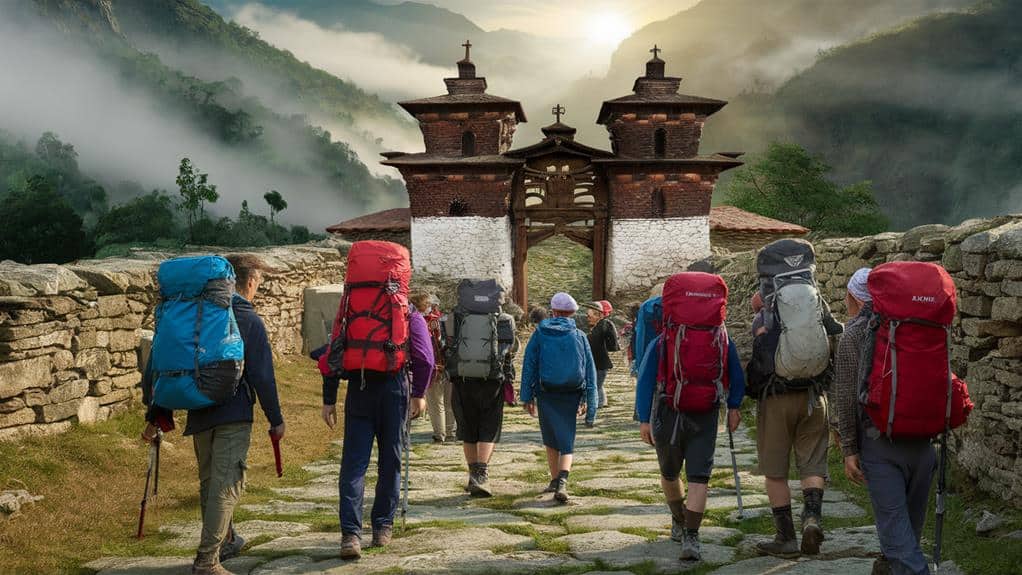
Today’s pilgrims are reimagining ancient sacred routes through a contemporary lens, blending traditional practices with modern sensibilities. You’ll find yourself walking paths once trodden by medieval seekers, yet you’re equipped with GPS tracking and ultralight gear, creating a unique fusion of old and new.
As you navigate these timeless trails, you’re part of a growing movement that’s redefining what it means to undertake a sacred journey in the digital age.
You’ll discover that modern interpretations haven’t diminished the transformative power of these ancient paths – they’ve added new layers of meaning. Whether you’re walking the Camino de Santiago with a smartphone app or exploring Buddhist circuits in Asia through organized tours, you’re participating in a living tradition that continues to evolve.
The essence remains unchanged: the search for meaning, connection, and transformation. Yet now you’re able to share your insights instantly with a global community of fellow seekers, creating a web of shared experience that transcends geographical boundaries.
Through social media and online forums, you’re connecting with others who understand that these sacred journeys aren’t relics of the past but crucial channels for contemporary spiritual exploration.
Pilgrimage Across World Religions
Throughout history, sacred journeys have woven through the fabric of every major faith tradition. You’ll find Muslims undertaking the Hajj to Mecca, Buddhists circling the stupas of Bodhgaya, and Christians walking the Via Dolorosa in Jerusalem. Each path holds its own mysteries, yet they’re bound by common threads of transformation and devotion.
In Hinduism, you’ll discover pilgrims bathing in the sacred Ganges, while Jewish travelers make their way to the Western Wall in Jerusalem. These aren’t mere tourist destinations – they’re portals where heaven and earth seem to touch.
As you explore these traditions, you’ll notice how pilgrimage transcends simple physical movement, becoming a metaphor for life’s spiritual journey.
Whether you’re climbing Japan’s Mount Kōya or walking Spain’s Camino de Santiago, you’re participating in an ancient practice that connects you to millions who’ve walked before you.
These paths don’t just lead to sacred sites; they guide you through inner landscapes of contemplation and revelation.
In every tradition, pilgrimage offers you a chance to step outside ordinary time and into sacred space, where transformation becomes not just possible but inevitable.



